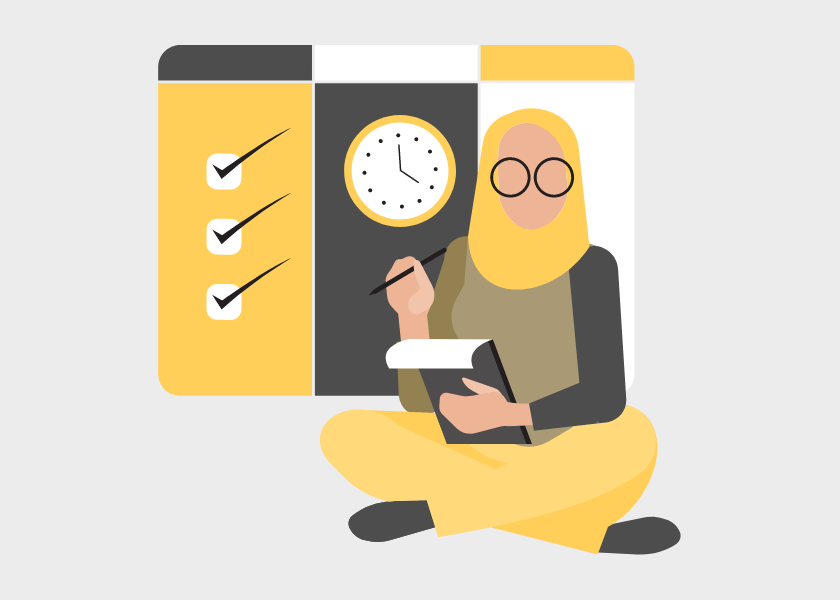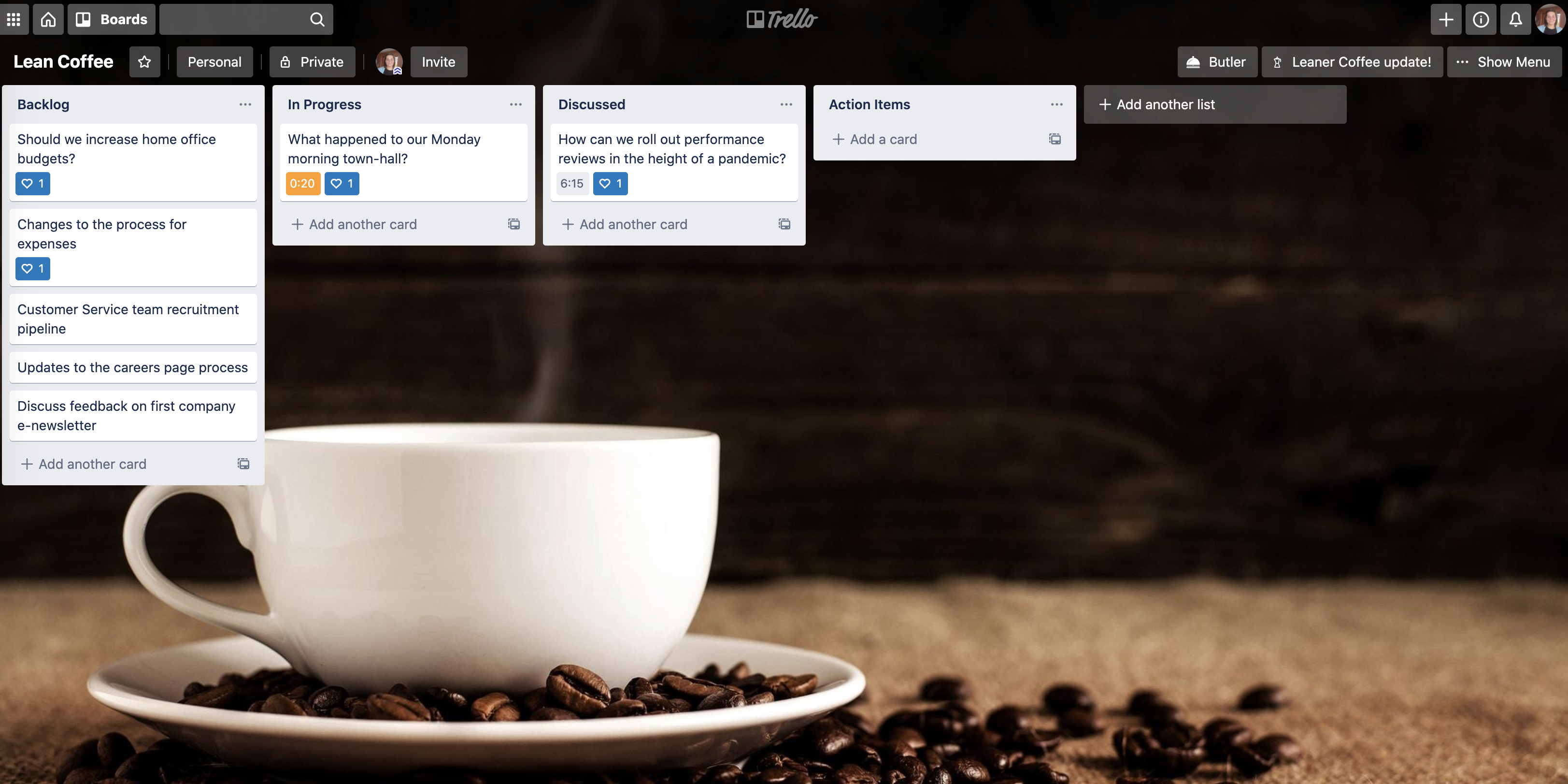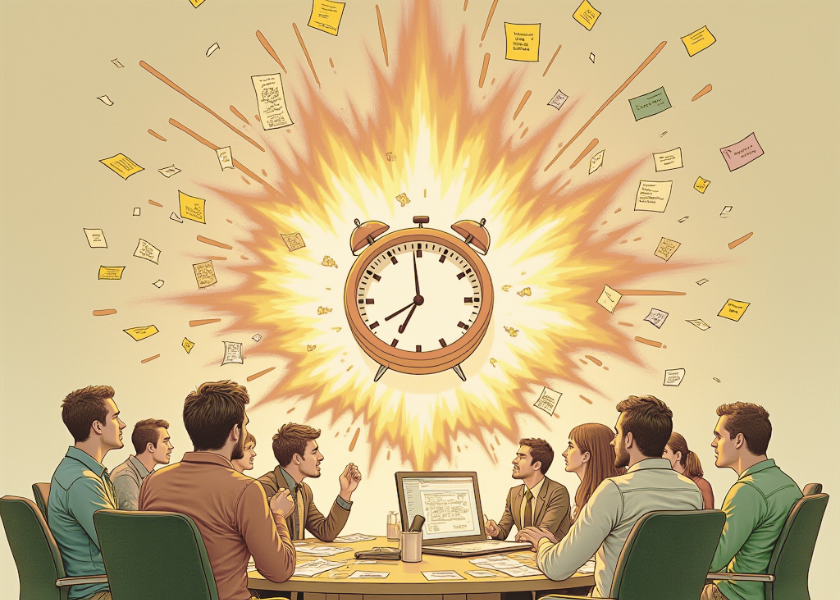Lean Coffee
Democratize your meetings and spark unexpected discussion.

As facilitators, we're often asked for ways to shake up meetings or ideas for meeting formats. We're not a big fan of novelty for the sake of it but there is one format that we often find ourselves coming back to with groups. We wanted to share more about that, so that you can try it out too.
It's called Lean Coffee. It was created by Jim Benson and Jeremy Lightsmith in Seattle in 2009.
At a high-level, Lean Coffee gives the people attending a given meeting an opportunity to raise topics they feel are necessary to discuss. It includes everyone in the team by giving each person an equal opportunity to contribute to the agenda and control the flow of the meeting by saying whether or not what is being discussed is valuable.
How does it work?
The Lean Coffee process itself is easy to learn and easy to facilitate. It emerged as a way to create structured but agenda-less meetings. It combines the concept of Lean Thinking with the informality of meeting in a cafe for a chat.
The group begins by generating a backlog of topics that each person is proposing the group discusses. You'll want to take a second to merge duplicate topics and if similar ideas are proposed check in with the group to see if they would like to discuss these separately or merge them. Some groups will have a speed round where anyone who wrote a sticky note provides a 10-second verbal synopsis of what that topic is about. This is simply to add further context before the group prioritizes the stack.
Through a process called dot voting, those topics are stack ranked. Then conversation begins with the topic that is at the top of the stank. It proceeds in 5 minute increments.
Every 5 minutes the group is asked to vote on whether to continue the discussion or move to the next highest ranked topic. In the voting, majority rules. If you end up with a 50/50 split, you can also choose to interpret that as a move-on. In person, you'd use thumbs up and thumbs down. Virtually you can do the same but it's much easier to use a poll tool (like the ones built in to Zoom and Butter).
One thing that's important is the visibility of the timer to all participants as it helps everyone raise their self-awareness of their own airtime.
Then, as the group moves through topics, the backlog of topic stickies move across a kanban style board from the backlog to done.
The result of this process is a democratically sourced, prioritized and time-boxed set of discussions.
Since this format is a little different from what you might have with a traditional agenda, it can be easy to forget to capture what's said. However, you will still want a note-taker even for Lean Coffee. They'll need to be capturing key ideas, questions and actions.
What we really like about Lean Coffee sessions is that they often end up covering unexpected ground while still respecting the value of everyone's time.
Practical Considerations
It's worth noting that Lean Coffee sessions work best with small groups (ideally 10 people or fewer). If you have a larger group, you could consider splitting them into smaller groups and running separate sessions with each group.
You can use all kinds of tools for a Lean Coffee. There are templates set up in Mural and Miro. It's easy and free to do in Google Jamboard as well as in Trello.
One tool we like for this is Trello because it has a nice visual interface (and it's free). As a bonus, some helpful folks in the community have made a Power Up called Leaner Coffee. It includes the display of a timer and allows you to use distributed voting on your board. Even if you don't use that particular Power Up, you can easily set up the board with the columns shown in the image. You will still need to enable Trello's homegrown Power Up for voting.

Variation: Thinker Friendly Lean Coffee
If the focus of your group is on innovation or solving a problem, you may also be interested in trying what we call a 'thinker friendly' lean coffee. It biases a little more towards those of us who tend to think-speak-think versus speak-think-speak. And it's particularly good for more creative conversations.
In this variation, you follow the same kick off process but during the 5 minute rounds, whenever a topic is introduced, the group spends that time silently writing down thoughts (or sketching ideas) instead of discussing them. Then the following 5 minute round is a discussion of the things people wrote, which can continue in 5 minute rounds until there is a vote to move on. Then when a new topic is started, the group has another silent round as before, and so on and so forth.
FAQ
How many topics can each person contribute?
We don't usually limit this because the group gets to decide on the topics actually discussed.
How many votes does each person get?
Three votes are recommended in the original process. Importantly, we suggest scaling the number of votes per person with the number of topics. Specifically, divide the number of topics by 4 and then round up to the nearest whole number. So 4 topics gives people 1 vote, 5-8 topics gives them 2 votes, 9-12 topics gives them 3 votes, and so forth.
When shouldn't we use Lean Coffee?
Lean coffee isn't a solution to all meeting problems and so should be applied thoughtfully. Some examples of situations where lean coffee is probably not the best choice...
- When the meeting involves 2-3 people.
- When there is already a clear, detailed agenda.
Once you've run this kind of session a couple of times, it'll feel easy and you'll almost certainly find that your team wants to start holding such sessions regularly.
In that spirit, you can keep the board you built available for your next session. The backlog of topics can be rolled over (though we recommend you clear them out when they become irrelevant or when nobody recalls what they were about 😀).
Give it a try and let us know how it goes.
If your meetings need a bit more support, you might find our best-selling Fix Your Meetings program of interest. We'll help you make sure your meetings are a valuable use of everyone's time and energy.


